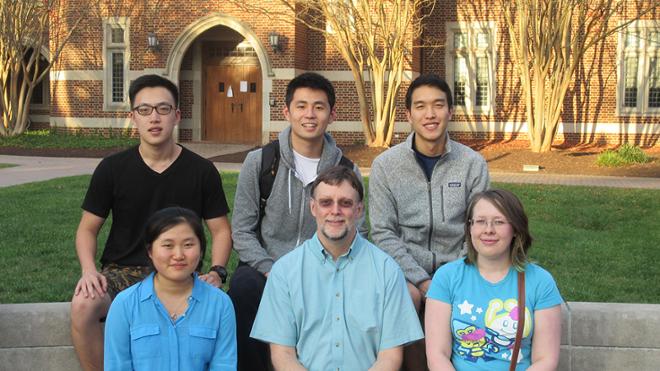Becky Chen, '16
Becky Chen, ’16, has always felt at home in the biology lab. “I like to be hands on, working in a wet lab where we mix things and measure things,” she said.
However, after an introductory computer science course, she wanted to explore something different. “I wanted to expose myself to more programming to see if that was something I wanted to consider as a career,” Chen said.
What she found was a way to bring together both of her interests through a summer research fellowship in math professor Michael Kerckhove’s lab.
Chen and her teammates spent their summer modeling foraging strategies for nematode bacteria in soil. Nematodes are bacteria that feed on other bacteria as a source of nutrients. The organisms have a membrane around them that can sense particles moving through their environment, and when they sense something is nearby, they move in a linear fashion toward the food source.
But what happens when pebbles, sticks, or other obstructions block a nematode’s ability to sense food nearby? That’s what Chen and her fellow researchers were testing through a previously developed model called Infotaxis.
According to Chen, Infotaxis suggests that, “the nematodes move in the direction where they can increase the amount of information they gain about the food source by collecting signals that they encounter on their path. They move in a spiral around a central area if they find that area has a maximum probability of having food; if it doesn’t, they move on a more linear path away from that site to start again.”
The group used a combination of biological lab experiments, differential equations, and modeling in two types of software programs to hypothesize how the nematodes were moving through Infotaxis.
First, Chen and a fellow lab mate spent time in biology professor Amy Treonis’ lab filming the nematode movements. “We were basically creating time-lapse videos of the nematodes using a dissecting microscope connected to a computer, seeing how they move without bacteria,” she said. “We needed to see their movements before we tried to model something.”
Armed with accurate information about their nematode subjects, the group then used the software programs Mathematica and NetLogo to test different scenarios, with an overall goal of reducing the distance the nematodes need to be from their food source in order to begin searching for food in an linear fashion, rather than in a spiral pattern.
After 10 weeks in front of her computer screen with her lab mates, Chen capped off her summer with a trip to the Mathematical Association of America’s conference to attend sessions and present the lab’s work. “I was just viewing it as a new experience, because I had never been to a math conference before,” she said.
Though she said she battled nerves and devoted a lot of time to preparing her remarks, it paid off when her presentation was recognized with the SIGMAA EM award, which is given to the best presentation that involves work on a problem arising from environmental sources.
Through the experience, Chen learned she prefers life in the biology lab over hours sitting in front of a screen. But she also gained new insights into the world of biology.
For one, nematodes may be microscopic in size, but Chen felt their impact on the scientific research community has the potential to be huge. “Nematodes are a useful organism for understanding a lot of biological processes,” she said. “I saw a talk not to long ago where the presenter was looking at how a nematodes neural network works, and trying to compare that to the human brain.”
Photo: Becky Chen, with lab mates Nicole Devine, Minuk Kim, Edison Wang, Bannong Zhang and mentor Dr. Michael Kerckhove. Not pictured: Matthew Brinnard and Dr. Amy Treonis.
